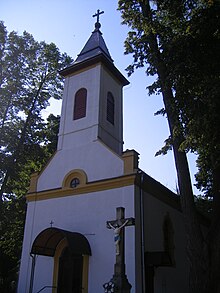Kosihy nad Ipľom
| Kosihy nad Ipľom | ||
|---|---|---|
| coat of arms | map | |

|
|
|
| Basic data | ||
| State : | Slovakia | |
| Kraj : | Banskobystrický kraj | |
| Okres : | Veľký Krtíš | |
| Region : | Poiplie | |
| Area : | 6.825 km² | |
| Residents : | 390 (Dec. 31, 2019) | |
| Population density : | 57 inhabitants per km² | |
| Height : | 140 m nm | |
| Postal code : | 991 11 (Post Office Balog nad Ip Postom ) | |
| Telephone code : | 0 47 | |
| Geographic location : | 48 ° 5 ' N , 19 ° 10' E | |
| License plate : | VK | |
| Kód obce : | 516139 | |
| structure | ||
| Community type : | local community | |
| Administration (as of November 2018) | ||
| Mayor : | Silvia Kosíková | |
| Address: | Obecný úrad Kosihy nad Ipľom č. 164 991 11 Balog nad Ipľom |
|
| Website: | www.kosihynadiplom.sk | |
| Statistics information on statistics.sk | ||
Kosihy nad Ipľom (until 1927 "Ipolské Kosihy" in Slovak; Ipolykeszi in Hungarian ) is a small community in southern Slovakia with 390 inhabitants (as of December 31, 2019). It belongs to the Okres Veľký Krtíš , a district of the Banskobystrický kraj .
geography
The municipality is located in the western part of the Ipeľská kotlina basin near the confluence of Veľký potok (literally Big Brook) in the Ipeľ , right on the border with Hungary . The center of the village is at an altitude of 140 m nm and is 21 kilometers from Šahy and 27 kilometers from Veľký Krtíš .
Neighboring municipalities are Trebušovce in the north, Veľká Čalomija in the east, Dejtár (H) in the south and Dolinka in the west.
history
The place was first mentioned in writing in 1248. In 1828 there were 75 houses and 448 inhabitants, who were mainly employed as farmers.
Until 1918/1919, the place in Hont County belonged to the Kingdom of Hungary and then came to Czechoslovakia or now Slovakia. Due to the First Vienna Arbitration Award , it was once again part of Hungary between 1938 and 1945.
population
According to the 2011 census, Kosihy nad Ipľom had 470 inhabitants, 357 of whom were Magyars , 93 Slovaks and three Roma . 17 residents did not provide any information on ethnicity .
439 residents supported the Roman Catholic Church, two residents of the Evangelical Church AB and one resident of the Baptists; five residents professed a different denomination. Four residents were non-denominational and the denomination of 19 residents was not determined.
Buildings and monuments
- Roman Catholic church in neoclassical style from 1899
- Country house in the classical style from the end of the 18th century
Sons and daughters of the church
- Arnold Ipolyi (1823–1886), Hungarian clergyman, historian and art historian
Individual evidence
- ↑ Results of the 2011 census (Slovak) ( Memento of the original from March 5, 2016 in the Internet Archive ) Info: The archive link was inserted automatically and has not yet been checked. Please check the original and archive link according to the instructions and then remove this notice.
Web links
- Entry on e-obce.sk (Slovak)

